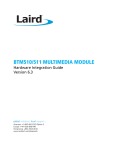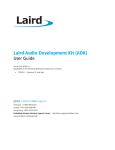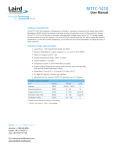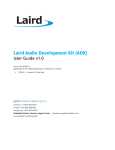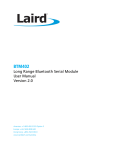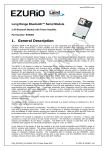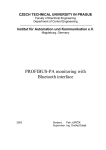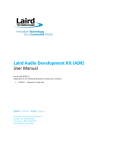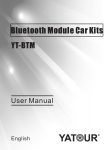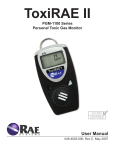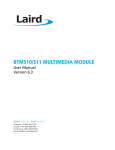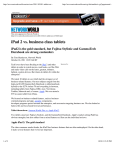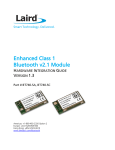Download BTM51xx Features and Benefits
Transcript
BTM5xx Series – FIRMWARE v22.2.5.0 FEATURES AND BENEFITS Application Note v1.0 INTRODUCTION This document refers to the following Laird part numbers: PART NUMBER DESCRIPTION BTM510-09 Bluetooth Multimedia Module with external antenna BTM511-09 Bluetooth Multimedia Module with integrated antenna DVK – BTM510 Development Board with BTM510 soldered in place DVK – BTM511 Development Board with BTM511 soldered in place ® ® The BTM module family, with associated development kits, has been available as a mass production part since late 2010. As part of Laird’s commitment to continuous improvement and technical innovation, the product family has been consistently enhanced to provide key benefits for the global customer base. This document provides details and analysis of the enhanced feature set of the BTM51x series of Bluetooth Class 2 Audio modules from Laird as supported by firmware v22.2.5.0, which was made publically available in February 2015. BTM5 Series General Overview The BTM5 series consists of Class 2 Bluetooth modules designed to add robust audio and voice capabilities to OEM products. The modules, which are based on the market-leading Cambridge Silicon Radio (CSR) BC05 chipset, provide an integrated stereo codec and a 64-MIPS Kalimba DSP. Using additional soft codecs, designers can add features such as echo cancellation, noise reduction, and audio enhancement. The module range supports Bluetooth specification v3.0 with Simple Secure Pairing for improved security and easier user functionality. The BTM5 series offers significant time and cost advantages over an integrated or on-board solution. The modules carry a broad range of certifications – Bluetooth END product, FCC modular, MIC, IC and CE – and support contain an extensive Bluetooth profile suite including support for SPP, HFP, HSP, A2DP, and AVRCP. Support for a comprehensive AT command interface speeds integration and simplifies application development in the potentially complex world of mono and stereo audio products. A low-cost, feature-rich development kit further speeds customer’s time to market. The following table summarizes the advantages of BTM5 series modules over a Bluetooth chip: Device Life Cycle BTM5 Series Module Chip Because the module is a complete, full- Because a chip requires more planning for integration onto the target circuit board, time-to-market is longer. featured component, time-to-market is much shorter. Requires less integration effort. You can RF Design and Integration Support Cost rely on Laird’s expertise for the BT and RF design. Functions with simple and easy-to-use AT commands. Laird can provide on-going support and troubleshooting for the module. Involves the purchase of a single component. Fully approved from a Bluetooth SIG Fully Approved perspective and maintains a wide range of international RF approvals. Leveraging these approvals greatly reduces your testing time and compliance cost. Integration onto the host device’s board is more complicated; you must have your own RF design experts. Once you integrate a chip onto a PCB, you own the support responsibility. Involves the purchase of multiple components which may increase cost. Requires its own compliance testing for both Bluetooth and RF which increases time-to-market and cost. BTM5xx Series – Features and Benefits Application Note Market and Applications The BTM5 series has been designed into a wide range of OEM products that require a reliable Bluetooth wireless link for high-quality audio products. Two types of applications for which BTM5 series modules are a good fit are stereo streaming applications and mono voice applications. Stereo streaming applications include smartphone speaker docks, wireless hi-fi audio systems, automotive multimedia devices, and stereo headsets. Mono voice applications include VoIP phones and gateways, intercom systems, vehicle hands-free kits, first responder audio intercoms, and industrial audible alarm systems. PROFILE FEATURES / ENHANCEMENTS AVRCP v1.5 Upgrade Overview The update also incorporates an upgrade to version 1.5 of Audio/Video Remote Control Profile (AVRCP), CT role. The profile remotely controls audio or video streaming devices and has all the functionality of previous versions but now has extended control of the music player’s database, track information (metadata), (virtual) folder browsing, absolute volume control, player applications settings and more. The user interface provides users with the ability to control player application settings such as repeat mode and shuffle and indicates current playlists, “now playing”, play status change, etc. Unique to Laird, the latest production release of firmware (v22.2.5.0) for the BTM5 series provides UID cache index, which avoids handling of 64 bit UIDs on resource constrained host controller. Up to 10 UIDs of a list (AT+AVQFS) are cached when the list is printed. For a subsequent command, the UID index can be passed (‘0’…’9’) rather than the 64 bit UID itself. This feature is especially useful in the development phase as it helps to play with and understand browsing features more quickly. HFP v1.6 Wideband Speech Overview To speed product development and integration, Laird has developed a comprehensive AT command interface that simplifies application development, including support for audio and headset functionality. The Hands-free profile (HFP) defines how two devices supporting HFP shall interact with each other on a point-to-point basis. The use case for HFP is a hands-free unit that is connected wirelessly to an audio gateway. The audio gateway is typically a cellular phone. The hands-free unit acts as audio input and audio output of the cellular phone and allows control of typical telephony functions without physical access to the phone. The major benefit of upgrading to v1.6 of HFP is that it supports wideband speech (WBS). WBS uses a 16 kHz audio sampling rate, rather than 8 kHz, and a modified SBC codec (mSBC) to compress the voice data for bi-directional transmission over a limited bandwidth eSCO link. The higher sampling rate leads to a more natural sound of voice. Benefits As a result of continuous improvement, BTM51x now supports the HFP features “Voice recognition activation” and “remote volume control”. Voice recognition allows to remotely activate and send voice commands to speech recognition applications on a smartphone (e.g. Siri). This feature comes with GPIO support, enabling the user to toggle this function by a button from the hands-free device. Thanks to remote volume control, hands-free unit’s speaker volume and microphone gain can now be controlled by the audio gateway remotely. Vice versa, the audio gateway is informed whenever a gain change takes place at the hands-free unit. With new firmware update, ringtones are now available and can be used for either ringing purposes on HF or can be triggered at any time using AT commands.On top of this, users now also benefit from transparent access to the rfcomm link of a HFP or HSP connection (SLC/ACL). Whereas this layer used to be hidden from the user in the past, BTM51x now gives you the freedom to send and receive custom commands over SLC or ACL. The closely related ‘SLC spy’ feature allows you to analyse the rfcomm link for learning purpose and for debugging. Further improvement has taken place in the management of call records of the audio gateway instance (HFG): existing AT commands were enhanced to act more intelligent now, depending on the current states of active and held calls.You can set the AT commands using S-registers which are documented in the BTM5xx user guide which can be accessed from the Laird Embedded Wireless Support Site. In addition, access to GPIO pins allows mapping for direct connection to actuator buttons on headsets. Embedded Wireless Solutions Support Center: http://ews-support.lairdtech.com www.lairdtech.com/bluetooth Laird 2 Americas: +1-800-492-2320 Europe: +44-1628-858-940 Hong Kong: +852 2923 0610 BTM5xx Series – Features and Benefits Application Note Lower Power Consumption Overview Low power consumption presents a major challenge for wireless devices. Increasing numbers of battery driven devices, as well as environmental aspects, are main drivers of demand for optimized power consumption. The BTM5xx comes equipped with sniff mode and sniff sub-rating for HFP, HSP, and SPP. Sniff mode is a configurable power saving mode of operation for Bluetooth devices. Benefits In sniff mode, a device checks in preconfigured intervals for incoming data. The dormant periods are spent in a lowpower state, allowing the device to save power when not transmitting. Firmware v22.2.5.0 also comes equipped with additional power saving features such as automatic sniff mode/ sub-rating for A2DP and AVRCP, automatic management of discoverable/ connectable for multiples profiles based on connect and disconnect events (AutoBTX) and optimized pre-defined power settings AT&F<x> with x=[0…8]. Other Overview BTM5xx modules include additional updates such as multi profile specification (MPS) compatibility layer for A2DP, AVRCP, and HFP, improved compatibility for pairing with Android devices, convenient display of link key type (unauthenticated/authenticated), CSR Bluestack 26 g ADK2.5, and multiple bug fixes which are listed in the firmware release notes. The release notes can be accessed from the Laird Embedded Wireless Support Site. CSR ADK v2.5 Support Overview The latest production release of firmware for the BTM5 series (firmware version 22.2.5.0) incorporates an upgrade to ADK 2.5 from CSR for the BC05 MM chipset. Laird’s implementation of the ADK 2.5 in our AT command set contains upgraded A2DP encoders and decoders that are hard-coded inside firmware. Benefits This benefit is further enhanced by built-in support for the apt-X™ audio codec for wireline-quality stereo audio. This audio compression solution provides for the highest quality audio with very low latency for audio streaming devices. Support is available at no additional charge. The BTM5 series also supports Bluetooth’s standard SBC (SubBand Codec) and the AAC (Advanced Audio Codec), which is Apple’s preferred codec for iOS devices. (AAC technology is IP owned by numerous third parties and requires an independent license for use in the finished OEM product. For details please visit http://www.vialicensing.com.) In summary, the BTM5 series supports the following A2DP encoders and decoders: Encoders (A2DP source role): SBC, APTX Decoders (A2DP sink role): SBC, APTX, AAC Soft codec support in standard production firmware enables customers to seamlessly support the vast majority of codec implementations found in today’s electronic devices. Simultaneous Profile Support Overview The comprehensive AT command structure implemented on the BTM5 series allows customers the flexibility to support multiple Bluetooth profiles simultaneously. Laird’s years of experience in embedded Bluetooth applications have helped to illuminate specific customer use case scenarios that can only be realized by supporting simultaneous device profiles. Embedded Wireless Solutions Support Center: http://ews-support.lairdtech.com www.lairdtech.com/bluetooth Laird 3 Americas: +1-800-492-2320 Europe: +44-1628-858-940 Hong Kong: +852 2923 0610 BTM5xx Series – Features and Benefits Application Note Usage Example A customer implementing a Bluetooth wireless solution for first responders needed the ability to have a voice communications to BT-enabled gateway cellular device, as well as a data stream for sensor data. The BTM5 series AT command set handles this effortlessly by supporting Headset Profile (HSP) for the mono voice telephone and Serial Port Profile (SPP) for the data channel. Similarly a customer required the ability to stream stereo audio for playing music files from their device and a data stream for GPS data – implemented by simultaneously using A2DP and SPP. Flow Diagrams 1-5 in the Role Switch section outline the various scenarios that are easily addressed within the module’s firmware. Role Switch Better control on Bluetooth links is achieved by new AT commands, allowing to request an HCI role change (master/slave) either manually or automatically on connect. This helps to improve Bluetooth performance in particular use cases, e.g. when an A2DP link is initiated from BTM5 to a phone. ** Note: Some combinations of the HSP/HFP configuration may be complex due to the actual role specified. For example, simultaneously enabling the Gateway plus Headset/Hands-Free role results in an unresponsive system. Enabling both Handsfree/Headset unit (HF/HS) and the complementary audio gateway role (HFG/HSG) simultaneously is no longer recommended.Please contact your local Laird FAE for further information. Embedded Wireless Solutions Support Center: http://ews-support.lairdtech.com www.lairdtech.com/bluetooth Laird 4 Americas: +1-800-492-2320 Europe: +44-1628-858-940 Hong Kong: +852 2923 0610 BTM5xx Series – Features and Benefits Application Note AUDIO ENHANCEMENTS Audio Overview In the latest firmware update, I2S format is controlled by S-register, rather than by PSKEY, and functions can be tested by the I2S cross loopback mode feature. In addition, the new firmware allows cross loopback from analogue to I2S or PCM, allowing analogue to I2S/PCM conversion for enhanced testing. In the BTM5xx module, analogue audio input (stereo) is routed to SD_OUT and at the same time SD_IN is routed to analogue audio output (stereo). I2S cross loopback mode is enabled by AT+BTL3 (I2S master role) or by AT+BTL4 (I2S slave role). Constant Sampling Rate Constant sampling rate is an important feature that applies to both A2DP (Sink) and SCO audio. It is needed if an external hardware codec is used via PCM or I2S interface (rather than the on-board ADC/DAC). The resampling algorithm, running on the internal DSP, adjusts automatically to the current air rate. Whether there is an A2DP link with 48kHz or 44.1kHz air rate (audio sink) ongoing or whether a narrowband SCO (8kHz) or a WBS link is active, the I2S interface will present the audio stream at the chosen rate (e.g. 48kHz) in all cases. Clear Voice Capture (CVC) In order to further improve the audio quality supported by the BTM5 series, Laird has included Clear Voice Capture (CVC) (7th generation)in the module firmware. Based on CSR ADK 2.5.1, the most recent firmware version, 22.2.5.0, includes CVC 7th generation, which enables noise reduction and echo cancellation. CVC is a technology provided by Cambridge Silicon Radio (CSR) which utilises the BC05 internal DSP in order to improve the audio quality of SCO links (speech). This includes sophisticated noise reduction and echo cancellation. CVC works with both single and dual-microphone headsets, giving advanced audio enhancements and noise suppression to the near and far end as well as providing packet loss and bit error concealment. Implementation Overview of CVC The BTM5 series provides for three different usage scenarios -- Headset with one microphone, Headset with two microphones, and Hands-Free with one microphone -- with a separate DSP image for each, configurable by AT command. Whenever a SCO connection is established, the selected image is loaded on the DSP before the audio stream is connected. This is where the support of AT commands for CVC ends. From the beginning of a SCO connection with CVC, the customer will use CSR tools, namely “Universal Front End (UFE)/ Universal Parameter Manager” to parameterise and tune the CVC algorithms. UFE is a powerful GUI that allows to hear new parameters immediately as they are written to the DSP for easier tuning. CSR provide documents which describe not only the details of how to tune their CVC algorithms, but also what needs to be taken into account when designing a headset (e.g. mechanics, position of microphones etc.) At the end of the tuning phase, a *.psr file will be created by UFE, containing all DSP parameters. Once the customer has finished the tuning phase, the DSP parameters need to be written to the BTM51x module in the customer’s production environment. For this purpose, Laird provide a tool called “PsUpdate.bat” which will modify PSKEYS (DSP parameters) over UART. Using this tool guarantees the Bluetooth SIG approval remains valid. In addition, a license key is required for the CVC image for production. This license key must be ordered from CSR approved distributors directly and written to the BTM5xx in the customer’s production environment using “PsUpdate.bat”. The license keys vary in price versus volume; one example, Digi-Key - part # BCSW-CVC-HS-1MFX, has one of the keys as $0.55 per key for a MOQ on 2000 keys. The Laird AT command set provides support commands for managing CVC license keys. This includes a check for a valid license key at boot time and when a SCO connection is entered. If a CVC image is loaded and the security check has failed, ERROR 83 is returned. Embedded Wireless Solutions Support Center: http://ews-support.lairdtech.com www.lairdtech.com/bluetooth Laird 5 Americas: +1-800-492-2320 Europe: +44-1628-858-940 Hong Kong: +852 2923 0610 BTM5xx Series – Features and Benefits Application Note In order to further assist customers with CVC integration, Laird has produced a detailed Application Note to cover all aspects of the process. In order to access this information, which includes CSR specific information and IP, a Laird NDA needs to be completed – please contact your local Laird sales representative to expedite this process. The diagram below shows a pictorial example of the CVC Development process and Appendix A covers an example of simple AT commands required to set up the enhanced audio link. Music Manager The Music Manager is a Windows based application that allows you to configure and monitor A2DP post processing algorithms. The Music Manager is available with the appropriate version of a Headset Application Development Kit (ADK). It is important to use the version of Music Manager which corresponds to the DSP images contained in a BTM51x firmware release. ATI38 helps identifying the image versions: The string ADK2.5 indicates that Music Manager which comes with CSR’s ADK2.5 is the appropriate version to configure DSP post processing for each of the 3 A2DP decoders contained in this BTM51x firmware release. These decoders provide a collection of audio effects to enhance or fine-tune audio output. Decoder Types: SBC Decoder AAC-LC Decoder APTX Classic Bluetooth Decoder (security key required) Audio Effects: Speaker Parametric Equalisation2 Bass Boost3 User Parametric Equalisation Stereo 3D Enhancement Embedded Wireless Solutions Support Center: http://ews-support.lairdtech.com www.lairdtech.com/bluetooth Laird 6 Americas: +1-800-492-2320 Europe: +44-1628-858-940 Hong Kong: +852 2923 0610 BTM5xx Series – Features and Benefits Application Note Compander Post Mastering (Noise Shaped Dither) Audio effects are provided for both 44.1 kHz and 48 kHz sample rates, and are supported for all the specified decoders listed above. The audio effects Stereo 3D Enhancement, and Dither algorithms are sample rate agnostic. However separate 44.1 kHz and 48 kHz sample rate tuning is required for the Speaker and User Parametric Equalisers, Bass Boost and the Compander. INTERFACE SUPPORT The BTM51x series is designed from the ground up to enable the widest array of audio applications for OEMs requiring mono and stereo audio capabilities. In order to provide a broad range of interface options, Laird provides for the following hardware interfaces on-board the module: UART Full 8-pin UART interface at 3.3 v logic level for command and data transfer. PCM Four (4) signal lines (lines shared with I2S) I2S Four (4) signal lines (lines shared with PCM) Enable use of external codecs or wave file player/recorder Select I2S master or slave role Enter Test mode: I2S cross loopback (internal codec), bidirectional audio If I2S is selected for A2DP sink, 44.1kHz and 48kHz are advertised as supported sampling rates in the SDP record (fixed). Hence, the external codec must support both rates. 4 x general purpose input/output support: 4 freely usable GPIOs available Function mapping (e.g. volume up/down, headset button etc.) AVRCP operation id mapping (e.g. Play/Stop/Pause etc.) 2 x LED output (Note: See the Automation section) AT commands for on/off/blink/pulse Automatic status indication (connectable/discoverable/connected/audio on) with a range of pre-defined blink patterns as of firmware version 18.1.4.0 GPIO LED AUTOMATION Overview The Automation features implemented into the latest v22.2.5.0 firmware provide OEMs with increased flexibility and scope for their end product implementation. These features allow the OEM to provide enhanced levels of functionality to their end users allowing for seamless, intuitive audio connectivity to smartphones and audio devices. Additionally the integration of higher level Bluetooth functionality into the BTM51x series modules reduces the processing burden for the OEMs host architecture, potentially reducing the overall BOM costs. Benefits Host-less operation by push buttons, no external microcontroller required, for typical stereo headset/speaker use cases Auto connect records allow configuration of automatic connections as soon as specified devices enter receiving range Status indication by LED blink patterns or GPIO outputs proving simple methodology to allow end users to determine Bluetooth connectivity status of the host device Embedded Wireless Solutions Support Center: http://ews-support.lairdtech.com www.lairdtech.com/bluetooth Laird 7 Americas: +1-800-492-2320 Europe: +44-1628-858-940 Hong Kong: +852 2923 0610 BTM5xx Series – Features and Benefits Application Note APPROVALS In order to speed OEM customers’ time to market, the BTM5 series of modules is fully approved from a Bluetooth SIG perspective and comes with a wide range of country RF approvals. This enables OEM customers to utilise the module’s approvals within their host product and significantly reduces the approvals/compliance costs – and overall risks – of launching a new product in mass production. The Bluetooth SIG approval held by the BTM5 series (Declaration ID D023160 - as of v22.2.5.0) is called ‘End Product Listing’ (EPL).This means that the module does not require any additional testing or approvals from a global Bluetooth perspective and allows the OEM to fully market their device using the Bluetooth name and logos. The only obligations for the OEM, as specified by the Bluetooth SIG, are that they apply to become a Bluetooth Adopter at the Bluetooth SIG and pay to list their final end device on the Bluetooth SIG EPL listing. A handy guide to the Bluetooth SIG process can be found at the end of the detailed HIG for the BTM51x. OEMs can take advantage of the modules following Regulatory Approvals: FCC Modular (USA): PI4510B (part # BTM510) and PI4511B (part # BTM511) IC (Canada): 1931B-BTM510 and 1931-BTM511 CE (Europe) : Declaration of Conformity incorporated into BTM51x User Manual MIC(Japan): R 201-125696 ADDITIONAL SERVICES Global Company – Local Support Laird is committed to providing a robust and reliable Bluetooth development experience for all customers, large or small. Each BTM5 series module and development kit is backed by a comprehensive User Manual, Quick Start Guides, product videos and most importantly by regional technical support through our global Field Application Engineer (FAE network). The FAE team is represented by support teams in Asia, Europe and the US who will assist customers through the complete product development cycle – initial evaluation, prototypes, pre-production and mass production roll out. Examples of the supporting documentation can be found in Appendix B with web links to the content. Embedded Wireless Solutions Support Center: http://ews-support.lairdtech.com www.lairdtech.com/bluetooth Laird 8 Americas: +1-800-492-2320 Europe: +44-1628-858-940 Hong Kong: +852 2923 0610 BTM5xx Series – Features and Benefits Application Note APPENDIX A – AT COMMAND EXAMPLE FOR CVC FUNCTIONALITY Prepare AT Command Settings The following AT command sequence needs to be sent to the BTM5xx in order to prepare it for CVC – headset 1 mic: AT Command (HF) Comment AT&F* Restore factory default settings ATS102=$10 Enable Bluetooth Hands-free profile -> Hands-free role. This does not mean that the CVC hands-free image must be used; it also works with CVC headset 1 mic image and CVC headset 2 mic image. HFP allows creation and closure of a SCO channel at any time from either end, therefore it is the most suitable BT profile for the CVC development phase. ATS512=4 Make module permanently discoverable and connectable ATS318=1 Select CVC image ‘headset 1 microphone’. See the section on Clear Voice Capture (CVC) for more information. AT&W Store settings ATZ Reset module. New settings take effect upon reset. ATI4 Query module’s Bluetooth device address. In this example the response should be 00025b00ff01. Will be required to initiate a connection to this device. Create an SCO Link For the CVC image to be loaded, a SCO link must be created. One option is to use a mobile phone as the audio gateway for HFP. A better option (at least for the development phase) is a second BTM5xx, e.g. a BTM51x development kit, because this allows full control over the SCO link (mobile phones often close the SCO link if no audio is being transmitted). This setup is outlined below. Figure 1: CVC example setup The second BTM5xx is configured as follows: AT Command (HFG) Comment AT&F* Restore factory default settings ATS102=$40 Enable Bluetooth Hands-free profile -> audio gateway role ATS512=4 Make module permanently discoverable and connectable AT&W Store settings ATZ Reset module, new settings apply from now onwards ATI4 Query module’s Bluetooth device address. Will be required if we are going to initiate a connection to this device. Embedded Wireless Solutions Support Center: http://ews-support.lairdtech.com www.lairdtech.com/bluetooth Laird 9 Americas: +1-800-492-2320 Europe: +44-1628-858-940 Hong Kong: +852 2923 0610 BTM5xx Series – Features and Benefits Application Note Currently, CVC is not supported for the audio gateway role of neither HFP nor HSP. In most use cases, the audio gateway will typically be a mobile phone. Now we can initiate the HFP link. The link can be initiated from either end, in the first table the link is intiated from the HF device (BTM5xx with S318=1) : AT Command (HF) Comment AT+HFD<BdAddrHFG> Initiate HFP service level connection (SLC) , <BdAddrHFG> is what ATI4 returns on the HFG. At the first connection, a successful pairing should occur (“PAIR 0…”). Then we should see many HF indicators (“HFI…”) and the “CONNECT...” message AT+HFA Initiate audio (SCO) link. Response should be: FS8000,INT - sampling rate = 8000 Hz, internal codec CVCID B00A - CVC image with SYSID = 0xB00A loaded HF"AU1" - HF instance audio connection established Release the SCO link AT+HFR AT+HFH Release HFP Service level connection (SLC), If SCO link exists it will be released automatically ATH* Close all connections of the module. This command can be used alternatively to AT+HFH The second table lists AT commands for initiating the link from the HFG side (BTM5xx): AT Command (HFG) Comment AT+HFGD<BdAddrHF> Initiate HFP service level connection (SLC) , <BdAddrHF> is what ATI4 returns on the HF. AT+HFGA Initiate audio (SCO) link. Response should be: FS8000,INT - sampling rate = 8000 Hz, internal codec HF"AU1" - HF instance audio connection established Release the SCO link AT+HFGR AT+HFGH Release HFP Service level connection (SLC), If SCO link exists it will be released automatically ATH* Close all connections of the module. This command can be used alternatively to AT+HFH Embedded Wireless Solutions Support Center: http://ews-support.lairdtech.com www.lairdtech.com/bluetooth Laird 10 Americas: +1-800-492-2320 Europe: +44-1628-858-940 Hong Kong: +852 2923 0610 BTM5xx Series – Features and Benefits Application Note APPENDIX B - EXAMPLES OF THE CURRENT BTM5 SERIES DOCUMENTATION All of the following documents can be accessed from the Laird Embedded Wireless Support site. Bluetooth Audio Modules BTM510 / 511 Feature rich, BC05 Class 2 module for high quality audio and stereo Bluetooth applications. © Datasheet BTM510-511 User Manual Firmware Release Notes BTM510 – 511 to v22.2.5.0 Development Kit Schematics – BTM510 Development Kit Schematics – BTM511 BTM511 Development Kit Quick Start A2DP and AVRCP-v2 BTM511 Development Kit Quick Start HFP-v2 BTM511 Development Kit Quick Start SPP-v2 2015 Laird This document is issued by Laird Limited in confidence, and is not to be reproduced in whole or in part without the prior written permission of Laird . The information contained herein is the property of Laird and is to be used only for the purpose for which it is submitted and is not to be released in whole or in part without the prior written permission of Laird. Revision History Revision Date 1.0 17 Mar 2015 Description Initial Release Embedded Wireless Solutions Support Center: http://ews-support.lairdtech.com www.lairdtech.com/bluetooth Approver Jonathan Kaye Laird 11 Americas: +1-800-492-2320 Europe: +44-1628-858-940 Hong Kong: +852 2923 0610











